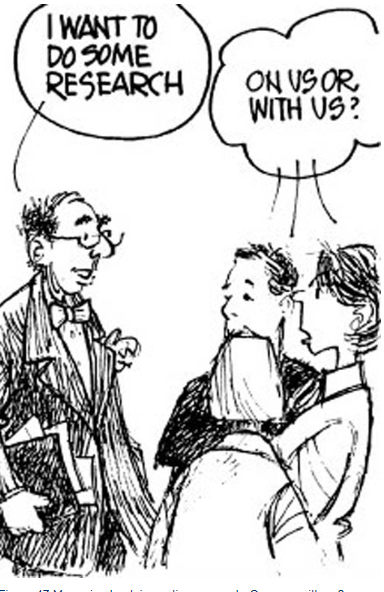4 Perspectives on ‘researching’
Systems practitioners may often work on complex situations to help others rather than themselves, and doing so as an observer of, rather than as a participant in the situation. Indeed many systems thinkers (some of whom you will be introduced to in Week 6) developed their ideas and practices around systems by researching and consulting work. And some of them devised specific approaches from these experiences (which you will hear about in Week 7) that can be taken and used by individuals to help with either ‘personal’ situations (one in which the individual(s) has (have) a clear stake or interest in the complex situation) or ‘private’ situations (one in which the individual(s) acts as a consultant or researcher for a client who has a clear stake or interest in the complex situation). This is particularly the case when we are looking at a purposeful system where there is a strong element of design or planning of the system of interest involved.
You will look at aspects of purpose again in Week 7 in relation to systems approaches; here you should focus on ‘involvement’ in a system of interest. Churchman (1971) has identified nine conditions for assessing the adequacy of design of any system of interest. He argues that these conditions must be fulfilled for a system to demonstrate purposefulness. Churchman (1979, p. 79) later reordered these nine conditions into three groups or categories of three conditions; each group corresponding with a particular social role – client, decision maker, and planner. Each social role is associated with two allied categories which Werner Ulrich (1983) later termed role specific concerns and key problems. Ulrich also identified each category group with a term reflecting the primary source of influence – motivation, control, and expertise – for client, decision maker, and planner (or ‘designer’) respectively (Ulrich, 1983, p. 250). These groups of conditions, roles and influences are set out in Table 1.
| Churchman’s 1971 nine conditions for a purposeful system (S) | Churchman’s 1979 three groups of three categories for a purposeful system | Ulrich’s 1983 sources of influence informing a purposeful system |
| Group 1 | ||
| Are the clients, the stakeholders of the system identified people whose interests and values will be served by the system? | social role: client | sources of motivation: whose purposes are served? |
| Is the system teleological? Does it exist to serve a purpose? (teleology means to have a purpose) | role specific concerns: purpose | |
| Does the system have a measure of performance? Are expected performances identified and are relevant measurements available, and are they carried out? | key problems: measure of performance | |
| Group 2 | ||
| Does the system have identified designers who serve the interest and values of the stakeholders? How are these interests and values known to the designers? Who is involved in validating the design? | social role: decision maker | sources of control: who has the power to decide? |
| Does the system have teleological components that co-produce the expected performance of the system? Do these components have measures of performance that are related to the performance of the system? | role specific concerns: components | |
| Is the system’s environment clearly defined? Is the relationship, the mutual interaction patterns between the system and its environment, defined? | key problems: environment | |
| Group 3 | ||
| Does the system have a decision-maker? (The client stakeholders, the designers, and the decision-makers can be the same.) | social role: planner/designer | sources of expertise: who has the know-how? |
| Do the designers intend to change the system so as to maximise its value to the client/stakeholder? Do they maintain fidelity between the preferred/ideal design and the operationalised design? | role specific concerns: implementation | |
| Is there a guarantee that the designers’ intentions are realisable? | key problems: guarantor | |
Footnotes
(Adapted from Ulrich, 1983, pp. 245–50)You will come back to these issues of who is involved in a systems investigation in Weeks 7 and 8 but now you will revisit the role of diagramming as technique for eliciting and capturing the perspectives of other people.

